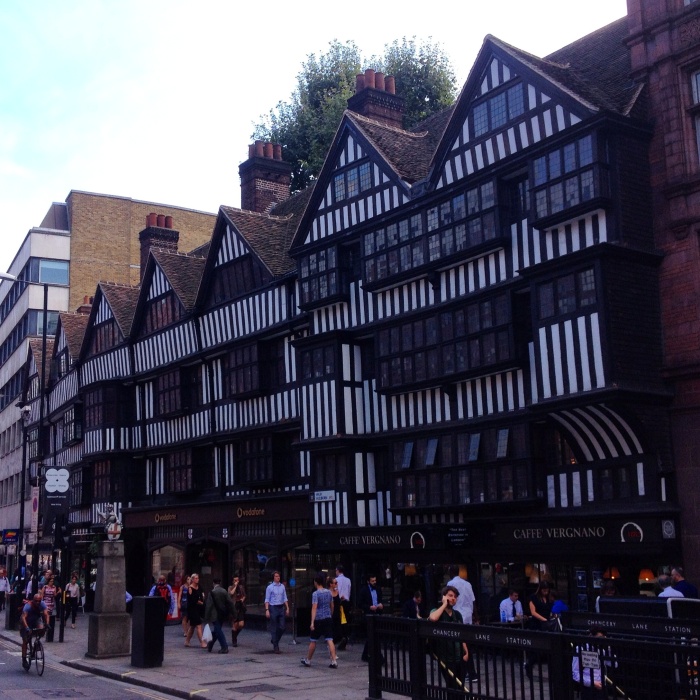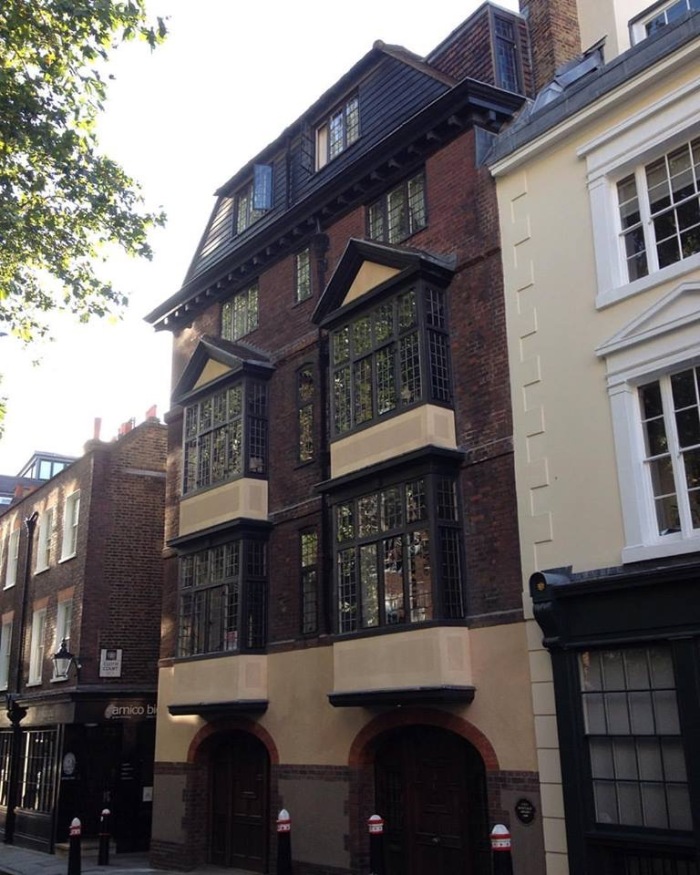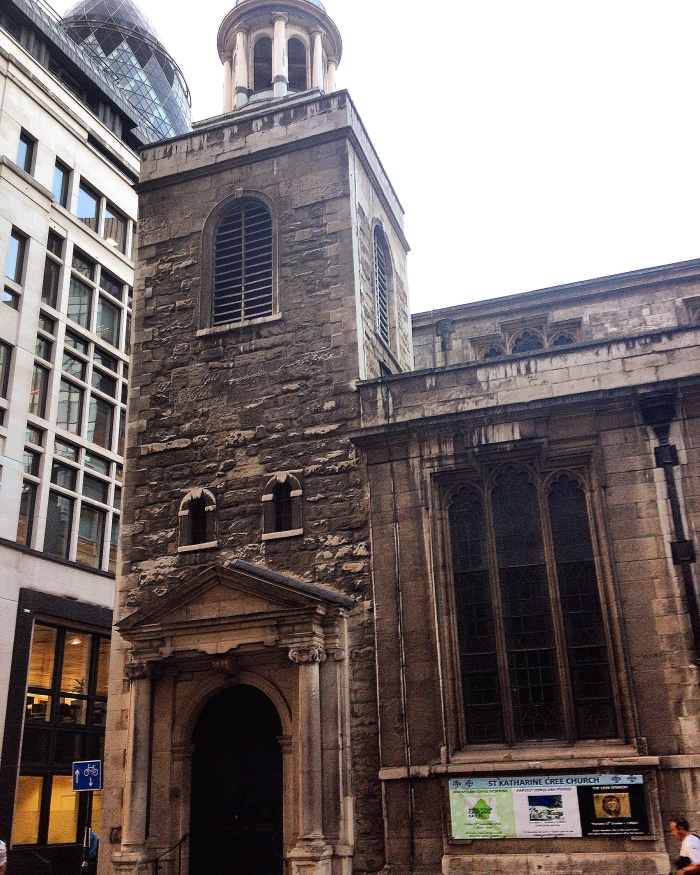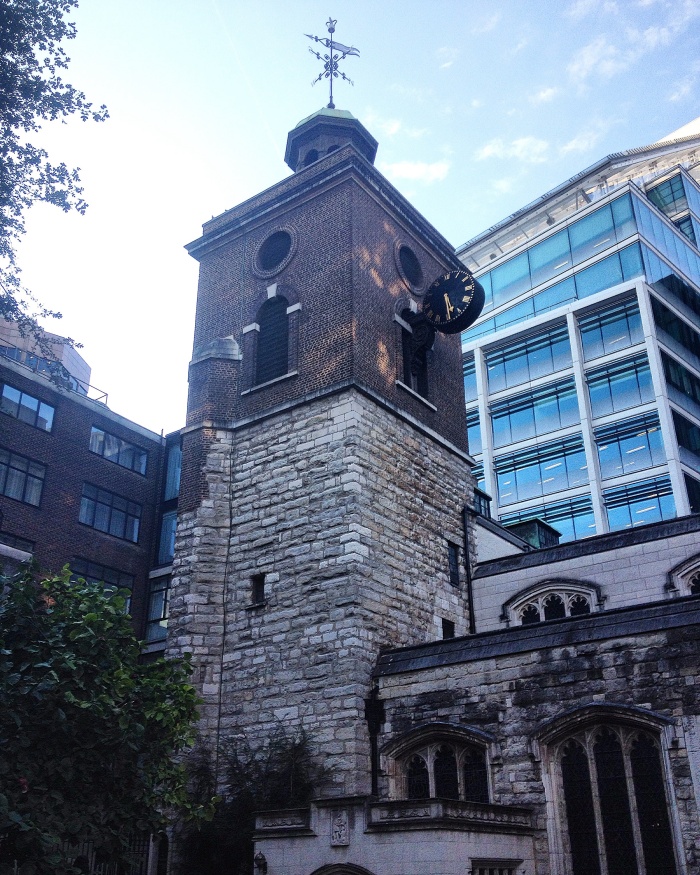Following on from my tour of the pubs of Glasgow back in October, I thought I’d share with you all my experiences of touring some of the oldest pubs of London. Some of these pubs go back to the times of medieval London before the Great Fire Of London of 1666. The history of London is fascinating in itself and some of these old pubs or taverns project a strong energy and spirit of what London must have been like all those years ago.
Ye Olde Mitre

This notorious pub, hidden down Ely Court in the Farringdon area, was first established in 1546. The bottom floor of the pub by the bar is full of hanging old beer mugs from the ceiling and historic photographs and pictures. The pub or tavern was originally built for the servants of the Palace of the Bishops of Ely from Cambridgeshire. The pub and palace were later destroyed in 1772. The pub in its current structure dates back to that year.

Inside Ye Olde Mitre
I prefer to come here for a pint during the afternoon when it is quieter and there are less punters. My favourite part of the pub is upstairs where there are many old pictures of historical figures like Mary Queen of Scots. When I was there with my sister back in August, we were the only people there. During the evening, especially on a Friday night, the pub becomes uncomfortably overcrowded and loud. The pub is currently owned by Fullers brewery and does a decent selection of beers and ales. When I was there I had an Oakham Green Devil IPA ale. A sterling choice but at 6% this stuff can make you weak in the knees quicker than you think.

St Etheldreda’s Church
If you have some free time, try to visit the atmospheric St Etheldreda’s Church which is the oldest Catholic Church in England built in 1291.
Ye Olde Cheshire Cheese

Number two of the Ye Oldes, this legendary pub, located on Fleet Street, was first established one year after the Great Fire Of London in 1667. What immediately strikes me about this pub is its heavy, wooden Old London austerity, rawness and darkness. You could have a thousand suns beaming down on this pub and inside it would still be darker than the blackest of hearses. This is not a place to go to for natural vitamin D therapy but if you want to experience the ghosts and grime of a time long gone, this is a great find.

Many literary figures including Mark Twain, Sir Arthur Conan Doyle, P.G Woodhouse and Dr. Samuel Johnson are all said to have been locals of this pub. Charles Dickens was also a regular of this pub and the atmospheric and ‘gloomy old London’ energy of the pub must have provided him with an abundance of inspiration for his writing.

Downstairs at Ye Olde Cheshire Cheese
Here this pub is at times a curious mix of one timer global smartphone-glued tourists and hardcore spit and polish long timer locals who’ve been drinking at this pub longer than I’ve been on this planet. My favourite part of the pub to sit is either in the small room where the bar is by the main back entrance or downstairs below the ground floor. It’s in these areas where I feel the spirit of the pub the most.
The Seven Stars

The Seven Stars is a special pub in London. Not only is it one of London’s oldest boozers first established in 1602, it also has the rare distinction of having survived the Great Fire of 1666. Fortunately none of the owners throughout the pub’s history have been shortsighted enough to redesign the pub in any shape or form and so it remains exactly as it was when it first opened its doors in the early 17th Century. Furthermore, it is one of the very few remaining independent old pubs in London.

Inside the Seven Stars
Since the pub survived the Great Fire and owing to the fact that it has hardly changed since its original beginnings, it offers a veritable taste of a typical medieval London tavern. A part of me would probably die if this place was ever turned into, god help me, a ‘gastropub’. What’s more, this pub has a decent selection of ales. When I was there with my sister, I had a pint of the dark Roadside Adnam ale which was very good.
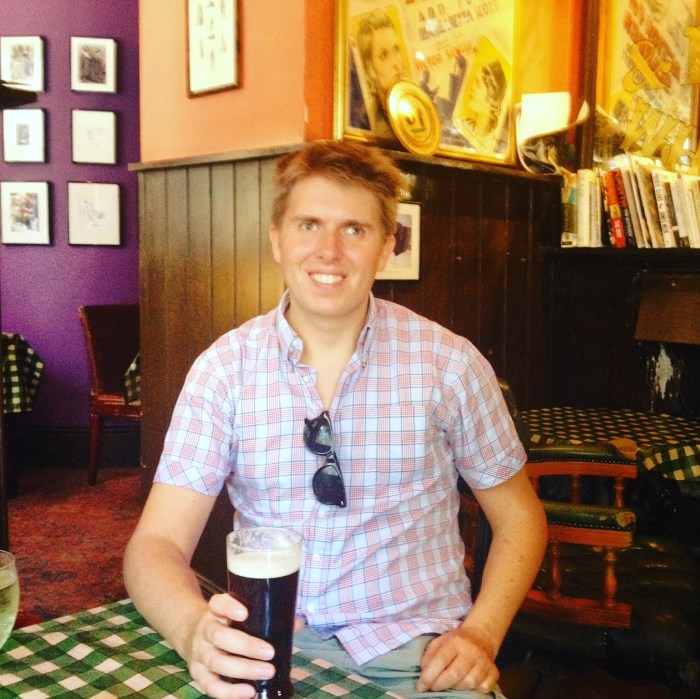
Yours Truly at the Seven Stars with a pint of Adnam ale
It is located by the Royal Courts of Justice and London School of Economics meaning that it is often frequented by LSE students and barristers who take their clients here for a celebratory drink.
The Cittie Of Yorke
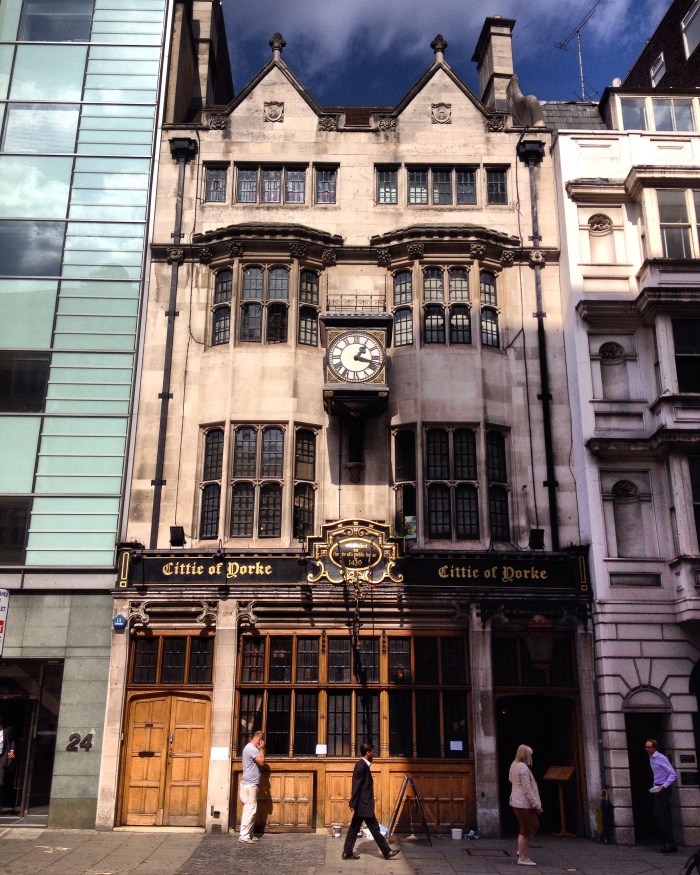
The Cittie Of Yorke is an outstanding old pub located in Holborn. It is a Samual Smith owned pub but is probably one of the most atmospheric pubs I’ve ever had the pleasure of visiting. The on site history of the pub goes back all the way to an impressive 1430 even if much of the current building is a rebuilding from the 1920s.

Inside the Cittie Of Yorke
The main bar area is situated in an awesomely atmospheric hall with high wooden beam ceilings, low suspending globe like lights and a series of big wooden beer barrels above the bar. More than many other pubs I’ve frequented, it is here where I could really imagine myself in a crowded, noisy and messy old London tavern. People would be dressed in rags or in immaculate suits, coats and top hats. I could imagine the former like being straight out of a painting by the 17th century Dutch painter Adriaan van Ostade who was a great painter of the Dutch underclass who spent there time in tavern like places getting drunk and merry and disorderly; tankards clinking, loud voices singing and a multiple of instruments ringing.

The legendary Welsh poet Dylan Thomas who was a great lover of pubs, wrote an impromptu ode to this pub when it was called the Henneky’s Long Bar. Aside from the main bar, there are some equally atmospheric rooms with dark wood furnishings, leather coaches, tall old windows and paintings.
The Hoop and Grapes

The Hoop and Grapes located on Aldgate High Street was originally built in 1593 and is one of the few existing relics of medieval London to have escaped the 1666 Great Fire. This current pub dates back to 1721 and is currently owned by the Nicholson Brewery. In spite of its unique history and all the old furnishings and photographs on the wall, this is quite an ordinary commercial pedestrian pub playing standard mainstream chart music. Unlike Ye Olde Cheshire Cheese, the original spirit of this place is hard to find.
The Anchor

This pub located on the South Bank has a very impressive history. This was William Shakespeare’s local and the pub from where the great London diarist, Samual Pepys, watched the Great Fire Of London. The genesis of this pub was a tavern reported to be 800 years old and this would make this place one of the oldest pub establishments in the city even if the pub had been destroyed during the Fire and subsequently remodelled a few times since then. The Anchor was recently refurbished in 2008.
Despite the epic and awesome history of the place and even the fact that the old decor remains, albeit with a slick facelift, it is quite an ordinary commercial pub serving the usual fare of alcoholic drinks and pub grub. Still it’s location on the South Bank can’t be beat and on a pure blue summer day, this is a good place to go.
The George Inn
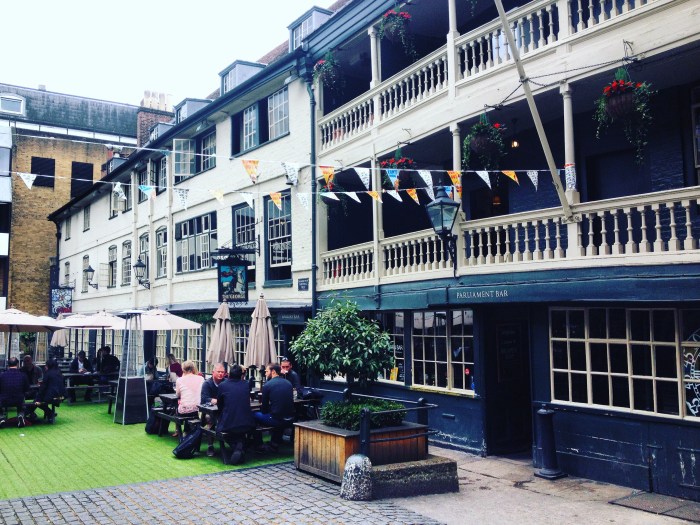
Located close to Borough Market and short distance walk from the Anchor, the George Inn is a gem of a pub and unlike the Anchor has retained much of its original character and charm. The George is a former coaching Inn dating back to 1542 and the current building dates back to 1676 after the original Inn was destroyed in a fire. The pub has also had a distinguished set of people who came here to drink. Most notably William Shakespeare and Charles Dickens. The latter mentioned The George in his novel Little Dorrit.
When I came here I had a pint of the locally brewed George Inn ale which I highly recommend. This is an outstanding pub and would be my personal choice over the Anchor if you happen to be in SE1.
The Prospect Of Whitby

The Prospect, located in Wapping, is one of the oldest pubs of London and the oldest riverside tavern of London dating back to 1520. It is also one of the best pubs I have ever had the pleasure of visiting. It was originally called The Pelican, which was later renamed The Devils Tavern and then later The Prospect of Whitby in the 18th Century. Back in those early days most of Wapping’s residents worked by the river as fishermen, sailors, and boat and sail makers. In addition to this, Wapping also had its fair share of pirates, thieves and smugglers.

Many famous people frequented the Prospect. ‘Hanging Judge Jeffries’ was a regular here. Throughout history it has been claimed that he would tuck into his lunch on the balcony of the pub whilst watching the hangings at a place then known as the Execution Dock. It was here where the notorious pirate Captain Kidd was executed in 1701. Then there was the 17th century London diarist Samuel Pepys who was a regular here during his stint as a clerk for the Navy and later Secretary to the Admiralty.
After the end of World War Two during the 1950s and 1960s, Wapping like many other parts of East London was in decline. However the pub was still doing brisk business and one of the pub’s rooms upstairs was a restaurant which was popular with many celebrities of that time including Richard Burton, Kirk Douglas, Frank Sinatra, Mohammed Ali and Princess Margaret.

One of the rooms in the pub upstairs was at one point in history used for boxing matches. Some of the earliest international matches happened between sea workers from around the world. As well as boxing matches, cock fighting matches also too place in this particular room.

I came here with a couple of friends one summers day back in September. We spent most of our time here on the outside riverside patio of the pub enjoying our pints and the beautiful weather. When we were not outside we were exploring the interior of the pub, it’s multiple rooms with old shipping memorabilia and paintings, portraits, photographs and records of all the distinguished people who crossed paths with this mighty place.
The Mayflower

From Wapping my friends and I take the Overground line one stop south of the river to nearby Rotherhithe. It is here that we visit the historic Mayflower pub. This pub was originally established in 1550 and then rebuilt in 1780 as the Spread Eagle and Crown before being renamed The Mayflower in 1957 after the Mayflower ship which took the Pilgrim Father’s from Rotherhithe to America in 1620.

Inside the Mayflower
The pub is atheistically a very tasteful pub with lots of old shipping related pictures and artefacts on the walls and around the pub. In a way it is the perfect vintage pub and it’s cosiness and warm vibe increase its attractiveness. It is best to come here when it isn’t crowded. When we came here there was a massive entourage of people celebrating something and we couldn’t move anywhere. But when it isn’t busy this pub is a delight. The riverside terrace is also one of the best in London.
The Angel
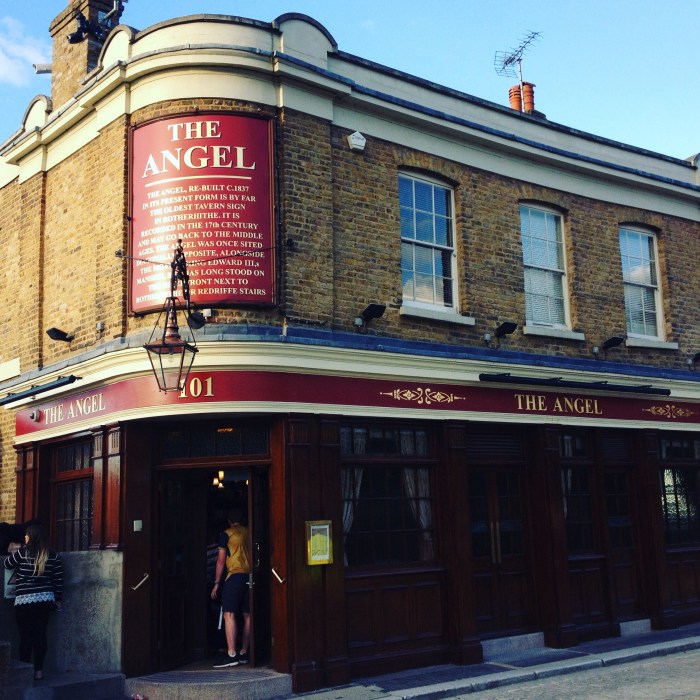
Also in Rotherhithe is the Angel pub. For me it is not as attractive or interesting as the Mayflower. The interior reminds me more of a tough East London boozer where the Kray brothers or one of the older EastEnders actors or Lennie McLean would call their local. Nevertheless, this Samuel Smiths pub is a good no nonsense boozer and has a long history. It was originally a 15th century tavern established by the monks of Bermondsey Priory. It is mentioned in Samuel Pepys diary as a place where he drank.
The Grapes

This unique riverside Limehouse pub has a history going back to 1583. The current building of the pub has a history dating back to the 1720s and was originally a raw working class riverside tavern serving predominantly the dockers of the Limehouse Basin. Regarding notable figures, our faithful friend Samuel Pepys makes an appearance here. His diary mentions trips to lime kilns at the jetty right by the Grapes.
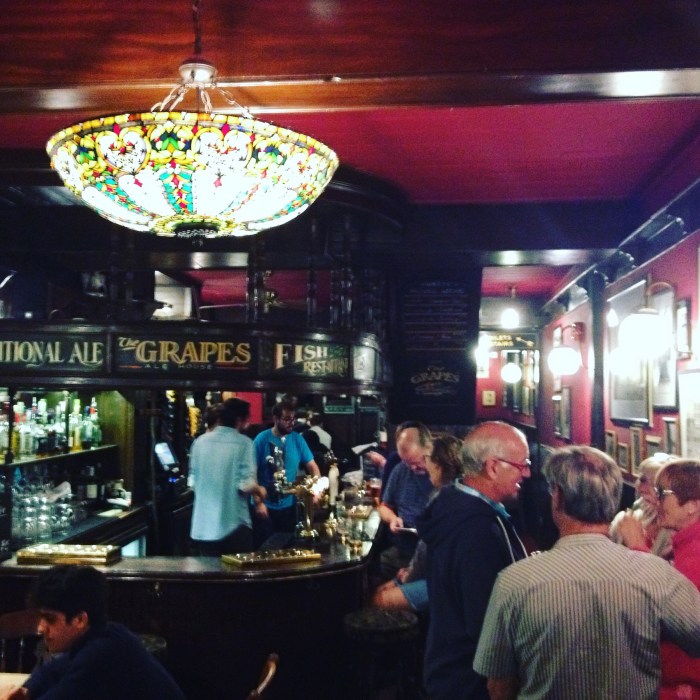
Inside The Grapes
The pub also appears in the Charles Dickens book Our Mutual Friend. The back of the pub is full of Dickens related paraphanelia including a large portrait painting of him.
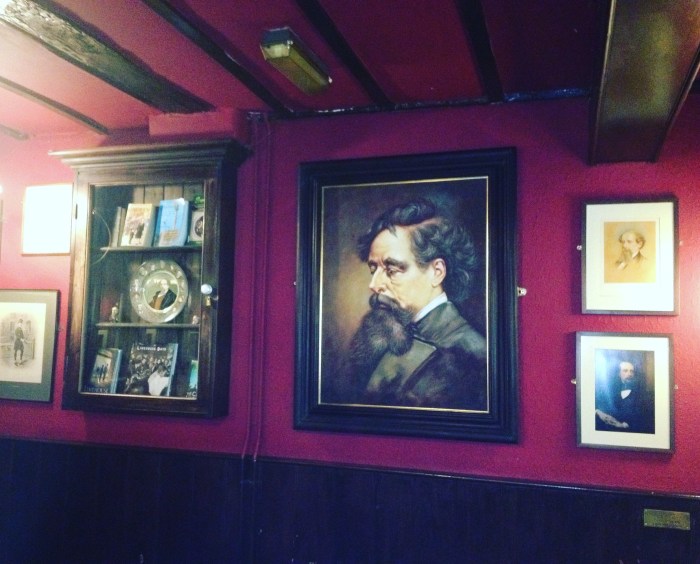
Portrait of Charles Dickens inside The Grapes
I like this pub. The interior and decor hasn’t been messed with and as a result it retains its original character and spirit.
Spaniards Inn
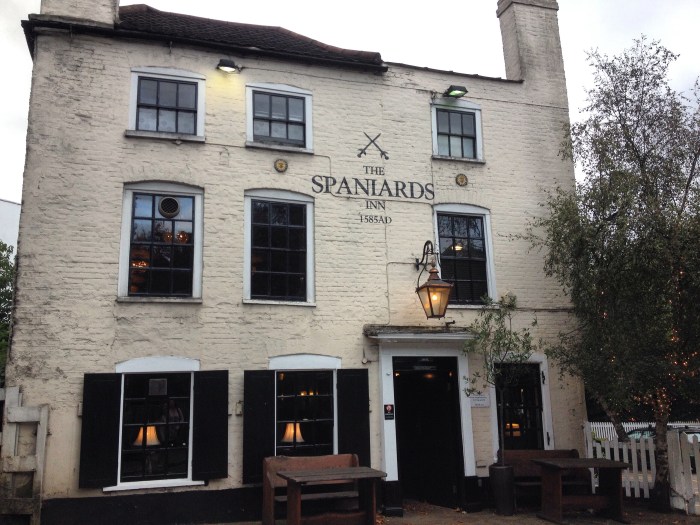
One day earlier this year I met a friend of mine in Hampstead. After a long walk in the beautiful Hampstead Health park, we visited this gem of a pub nearby. This attractive pub is one of London’s oldest pubs dating back to 1585 and is a great pub to visit full of original character and charm. There is also a large outdoor sitting area which is perfect for warm Spring and Summer days. This pub has a distinguished literary heritage. Dickens mentioned the pub in his book The Pickwick Papers and the poet Keats wrote Ode To A Nightingale here.
The Olde Wine Shades

Although more of an ancient wine bar than a pub, this place in the City of London nevertheless merits a mention more for its history and the fact that it is, like the Seven Stars pub in Holborn, a rare example of pre 1666 medieval London. It was one of the few buildings of that year to escape the Great Fire. Historical importance aside, I was quite disappointed to discover that it is nothing more than a mediocre overpriced wine bar. I would come here for a curious peep but I would rather pick the Seven Stars or the Prospect over this place any day of the week.
Text and photographs by Nicholas Peart
2nd December 2016
(All Rights Reserved)


